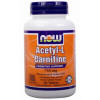
In our quest for cures, we tend to discount simple,
nothing-to-lose nutritional or herbal treatments in the debatable belief
that scientifically sophisticated, pharmaceutical approaches have more
merit. In fact, as highlighted in the table at the end of the article,
many commonly consumed nutritional/herbal supplements have considerable
potential to protect neuronal tissue (i.e., neuroprotective) after
spinal cord injury - perhaps, as evidence suggests, even as much as
current standard-of-care drug treatments. Because of their wide-spread
consumption in humans, safety is essentially already established for
these supplements; only human efficacy needs to be documented.
Unfortunately, there is little financial incentive to undertake the
costly testing required for these non-patentable supplements.
Acetyl-L-Carnitine
Joining the list of potential SCI therapeutic
possibilities is the amino acid acetyl-L-carnitine (ALC), a supplem ent
used for cognitive support and other purposes. It is a modified form of
L-carnitine, a substance abundantly found in red-meat and dairy products
and also produced to some degree by the brain, liver and kidneys. Unlike
many substances, ALC can pass through the blood-brain barrier and, as
such, exert physiological, neuroprotective effects on nervous-system
cells. Evidence suggests that ALC may be beneficial for Alzheimer’s
disease, stroke and age-related memory/thinking problems, late-life
depression, etc. Recent studies also suggest it may minimize
neurological damage after SCI.
ent
used for cognitive support and other purposes. It is a modified form of
L-carnitine, a substance abundantly found in red-meat and dairy products
and also produced to some degree by the brain, liver and kidneys. Unlike
many substances, ALC can pass through the blood-brain barrier and, as
such, exert physiological, neuroprotective effects on nervous-system
cells. Evidence suggests that ALC may be beneficial for Alzheimer’s
disease, stroke and age-related memory/thinking problems, late-life
depression, etc. Recent studies also suggest it may minimize
neurological damage after SCI.
Mitochondria
Basically, ALC exerts its neuroprotective effects
through enhancing the functioning and viability of all-important cell
organelles called mitochondria. Different human cell types can contain
from 1 up to 10,000 mitochondria, which power the cells by generating
the chemical fuel called adenosine triphosphate (ATP) needed to drive
most biochemical processes. So to speak, ATP is the gas that fuels our
vehicle.
Mitochondria are intriguing, semi-autonomous
organelles. For example, they possess their own DNA, which resembles
bacterial DNA more than the chromosomal DNA located in the cell nucleus.
Interestingly, you inherit mitochondrial DNA entirely from your mother,
who, in turn, got hers totally from her mother. Hence, although by and
large you are a genetic manifestation of all your ancestors, your
mitochondrial DNA has a continuous maternal lineage over the
generations. In other words, of all the 1024 theoretical ancestors you
had 10 generations ago, your mitochondrial DNA is a reflection of just
one.
Compared to the massive number of genes possessed
by chromosomal DNA, the mitochondrial genome includes only a few genes,
but they are critically important ones, encoding for the enzyme
complexes that generate the ATP fuel.
Because of their key importance, damage to the
mitochondria can be devastating to the cell, which unfortunately, is the
case for injury-affected neuronal cells. Specifically, mitochondrial
dysfunction plays a key role in the neuronal death cascade that
magnifies the damage after the initial traumatic insult.
Acetyl-L-Carnitine & SCI
Alexander Rabchevsky, Ph.D. and colleag ues
Samir Patel, Ph.D. and Patrick Sullivan, Ph.D. (University of Kentucky)
believe maintaining mitochondrial stability and bioenergetics is crucial
to promoting cell survival following SCI. They have carried out several
animal studies indicating that ALC preserves this stability after SCI by
serving as a backup substrate for the ATP-generating process, thereby
reducing the potential for post-injury oxidative damage.
ues
Samir Patel, Ph.D. and Patrick Sullivan, Ph.D. (University of Kentucky)
believe maintaining mitochondrial stability and bioenergetics is crucial
to promoting cell survival following SCI. They have carried out several
animal studies indicating that ALC preserves this stability after SCI by
serving as a backup substrate for the ATP-generating process, thereby
reducing the potential for post-injury oxidative damage.
In 2010, the investigators reported the results of
treating contusion-injured rats with ALC several times after injury.
After 24 hours, the rats were killed, and the mitochondria from their
injured spinal cords isolated. Compared with controls, ALC treatment
significantly maintained mitochondrial function. In rats treated for
seven days with ALC before being sacrificed, more viable tissue remained
around the injury site.
In 2012, these researchers extended these studies
by evaluating ALC’s influence on preserving hind-limb function in rats
with contusion SCI. As before, ALC treatment helped to preserve
mitochondrial function after acute injury and lessened the amount of
damaged tissue surrounding the injury site. In the recovery-of-function
experiments, rats were experimentally injured in the upper lumbar
region, an area thought to be critical to generating rhythmic hind-limb
movements. Fifteen minutes later they were treated with either ALC or
saline (control), a treatment repeated six hours later and daily for 21
days. Compared with the saline controls, ALC-treated rats showed
enhanced hind-limb movements as early as seven days after injury. After
four weeks, ALC-treated rats were able to functionally walk, while
control animals could only slightly move hind-limb joints. These
improvements were not documented when the injury was directed to a
different spinal-cord location not possessing the critical locomotor
neuronal circuitry.
The investigators concluded that their research
demonstrates that “preventing mitochondrial dysfunction acutely [i.e.,
at the time of the injury] promotes neuroprotection that may be
associated with the milestone recovery of …weight-supported stepping.”
Conclusion
By preserving the functioning of the all important
mitochondria after injury, ALC treatment lessens spinal-cord tissue
damage, in turn, enhancing functional recovery. Although we do not know
how truly effective it would be in humans, given it is a common, widely
consumed nutritional supplement, it seems that there is little to lose
and potentially much to gain by treating acutely injured patients with
ALC, perhaps in combination with standard-of-care treatments.
Nutritional & Herbal Approaches with SCI Treatment Potential